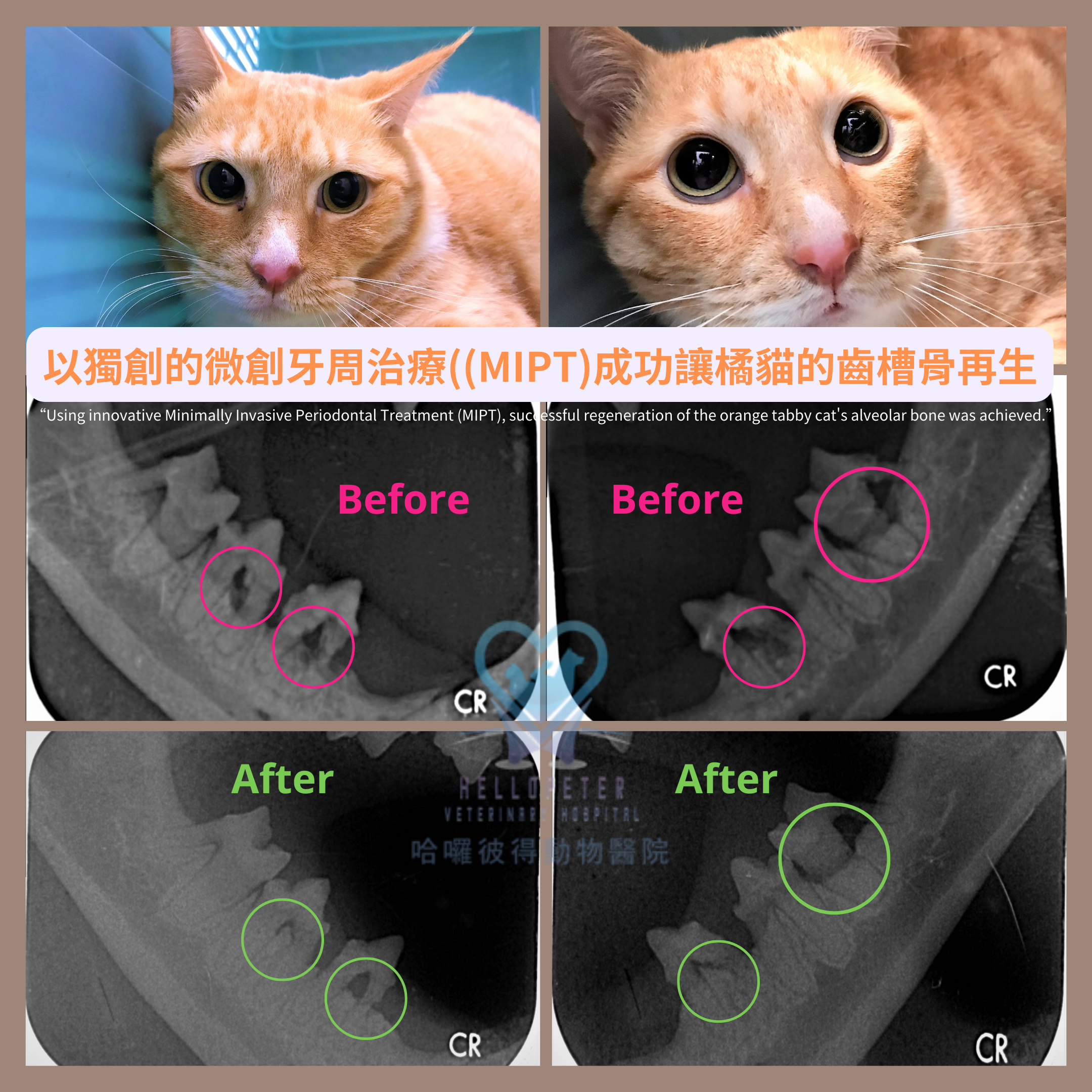 小柚是一隻3歲8個月的混種母橘貓,飼主在家裡覺得貓的牙齦紅腫而且有明顯口臭,遂帶至本院讓陳重威獸醫師進行全口洗牙及牙科檢查,同時評估治療。
小柚是一隻3歲8個月的混種母橘貓,飼主在家裡覺得貓的牙齦紅腫而且有明顯口臭,遂帶至本院讓陳重威獸醫師進行全口洗牙及牙科檢查,同時評估治療。
檢查結果發現小柚有嚴重的牙周病(periodontal disease),牙周組織的發炎導致了齒槽骨流失(alveolar bone loss)、根分叉病變(furcation involvement)與第一型齒吸收(type 1 tooth resorption),經評估後,本院建議幫小柚進行陳重威獸醫師研發的微創牙周治療(Minimally Invasive Periodontal Treatment, MIPT)進行療程。
經過6個月的治療後,小柚的牙齦紅腫消退,角化牙齦(keratinized gingiva)也開始重新覆蓋部份裸露的牙根,牙科X光檢查發現齒槽骨明顯再生、根分叉病變改善、齒吸收也有效控制住,飼主表示貓的口臭已經消失,活力與食慾良好,之後持續以每天刷牙及定期洗牙維持即可。
現行的牙周治療有很多方式,但都必須要以「確實洗牙」為基礎,才會有良好的效果;牙周再生手術(又稱導引組織再生手術,Guided Tissue Regeneration, GTR)和齒槽骨再生手術(又稱導引骨再生手術,Guided Bone Regeneration, GBR)對牙周組織(包括齒槽骨、牙齦、牙周韌帶等)的再生效果最好,但使用在狗貓上的限制和缺點也很明顯:
- 狗貓的牙齦的厚度普遍比人要薄,太薄的牙齦除了術中皮瓣容易破裂,也沒辦法有效進行減張(tension free)及良好的初級傷口縫合(primary closure),這使狗貓做GTR和GBR的難度比人要高,小型貓狗的手術難度也比中大型犬高。
- 齒槽骨的血液供應要良好、也要足以支撐填充物的形狀不會塌陷,GTR和GBR塞入的骨粉(bone graft)、膠原蛋白(collage)等填充物才能有效被利用讓牙周組織再生,而大部份患有牙周病前來就診的狗貓,都有嚴重的水平骨流失(horizontal bone loss),無法提供良好的血液供應與支撐,這會增加GTR及GBR手術失敗的機率。
- GTR和GBR手術的傷口較大,術後需要比較長的復原期,疼痛感比較大、術後感染的機率也比較高。
為了突破現有的牙周治療限制,陳重威獸醫師以洗牙為基礎,結合人醫牙科的研究成果,研發出也可適用於狗貓的微創牙周治療(Minimally Invasive Periodontal Treatment, MIPT),使牙周治療的傷口縮到最小,不需要擔心術後傷口癒合不良、疼痛及感染等問題,還有明顯的骨再生(bone regeneration)效果,讓更多牙周病的狗貓能夠接受良好的治療,且不需要使用到強效的止痛藥物。
“Using innovative Minimally Invasive Periodontal Treatment (MIPT), successful regeneration of the orange tabby cat's alveolar bone was achieved.”
Xiao-Yu (the name means “small pomelo”) is a 3 years and 8 months old mixed-breed female orange tabby cat. The owner noticed that her gingiva were swollen and there was a noticeable bad breath, so he brought her to our hospital for a comprehensive dental examination and scaling performed by Dr. Chung-Wei Chen (Dr. Richard Chen), at the same time, the treatment options were assessed.
The examination revealed that Xiao-Yu had severe periodontal disease, which resulted in inflammation of the periodontal tissues, alveolar bone loss, furcation involvement, and type 1 tooth resorption. After evaluation, we recommended the Minimally Invasive Periodontal Treatment (MIPT) developed by Dr. Chung-Wei Chen (Dr. Richard Chen) for Xiao-Yu's treatment.
After 6 months of treatment, Xiao-Yu's swollen gingiva subsided, and keratinized gingiva began to recover partially exposed roots, dental X-rays showed significant regeneration of the alveolar bone, improvement in furcation involvement, and effective control of tooth resorption. The owner reported that her bad breath had disappeared, and she had regained her vitality and appetite. It is now recommended to maintain tooth brushing every day and periodic scaling.
There are various approaches to periodontal treatment, but they all require thorough scaling as the foundation to achieve good results. Periodontal surgery such as guided tissue regeneration (GTR) and guided bone regeneration (GBR) have shown the best results in regenerating periodontal tissues, including alveolar bone, gingiva, and periodontal ligaments. However, there are evident limitations and drawbacks when using them in dogs and cats:
- The thickness of gingiva in dogs and cats is generally thinner than in humans, which makes the gingival flap prone to tearing during surgery, it also hinders effective tension-free closure and formation of a good primary closure, this increases the difficulty of performing GTR and GBR procedures on dogs and cats compared to humans. Additionally, smaller cats and dogs have higher surgical complexities compared to medium and large-sized dogs.
- Providing an adequate blood supply and to support the shape of inserted graft materials, such as bone graft and collagen, is essential in GTR and GBR surgery. Most dogs and cats with periodontal disease have severe horizontal bone loss, which compromises blood supply and support, increasing the risk of failure for GTR and GBR procedures.
- GTR and GBR surgery involve larger wounds and require a longer recovery period. They are associated with more significant pain and a higher risk of postoperative infections.
To overcome the limitations of current periodontal treatments, Dr. Chung-Wei Chen (Dr. Richard Chen) combined scaling as the foundation and incorporated research findings from human dentistry to develop Minimally Invasive Periodontal Treatment (MIPT) for dogs and cats. This approach minimizes the size of the wounds, eliminating concerns about poor wound healing, pain, and infection postoperatively. It also demonstrates noticeable bone regeneration effects, allowing more dogs and cats with periodontal disease to receive effective treatment without the need for potent analgesic drugs."
哈囉彼得動物醫院 |HelloPeter Veterinary Hospital
院長 陳重威獸醫師 |Dr. Richard Chen
YouTube頻道:【阿威獸醫師的開口啟齒】
www.youtube.com/@DrRichardChen_vet
(04)2472-8828
台中市南屯區東興路二段29號|No. 29, Sec. 2, Dongxing Rd., Nantun Dist., Taichung City 408, Taiwan
醫院官網Website:
www.hellopeter.com.tw
門診時間:週一至週五10:00~13:00、15:00~20:30(門診為預約制),週六可接受預約門診及手術,週日公休。
#
陳重威獸醫師 #
哈囉彼得動物醫院 #
HellPeterVeterinaryHospital #
動物牙科推薦 #
寵物牙科推薦 #
微創牙周治療 #
齒槽骨再生 #
骨再生 #
牙周再生 #
MinimallyInvasivePeriodontalTreatment #
MIPT
#
貓 #
貓牙周病 #
口炎貓 #
牙周病治療 #
cat #
dog
#
動物口腔外科 #
牙科獸醫 #
pet



